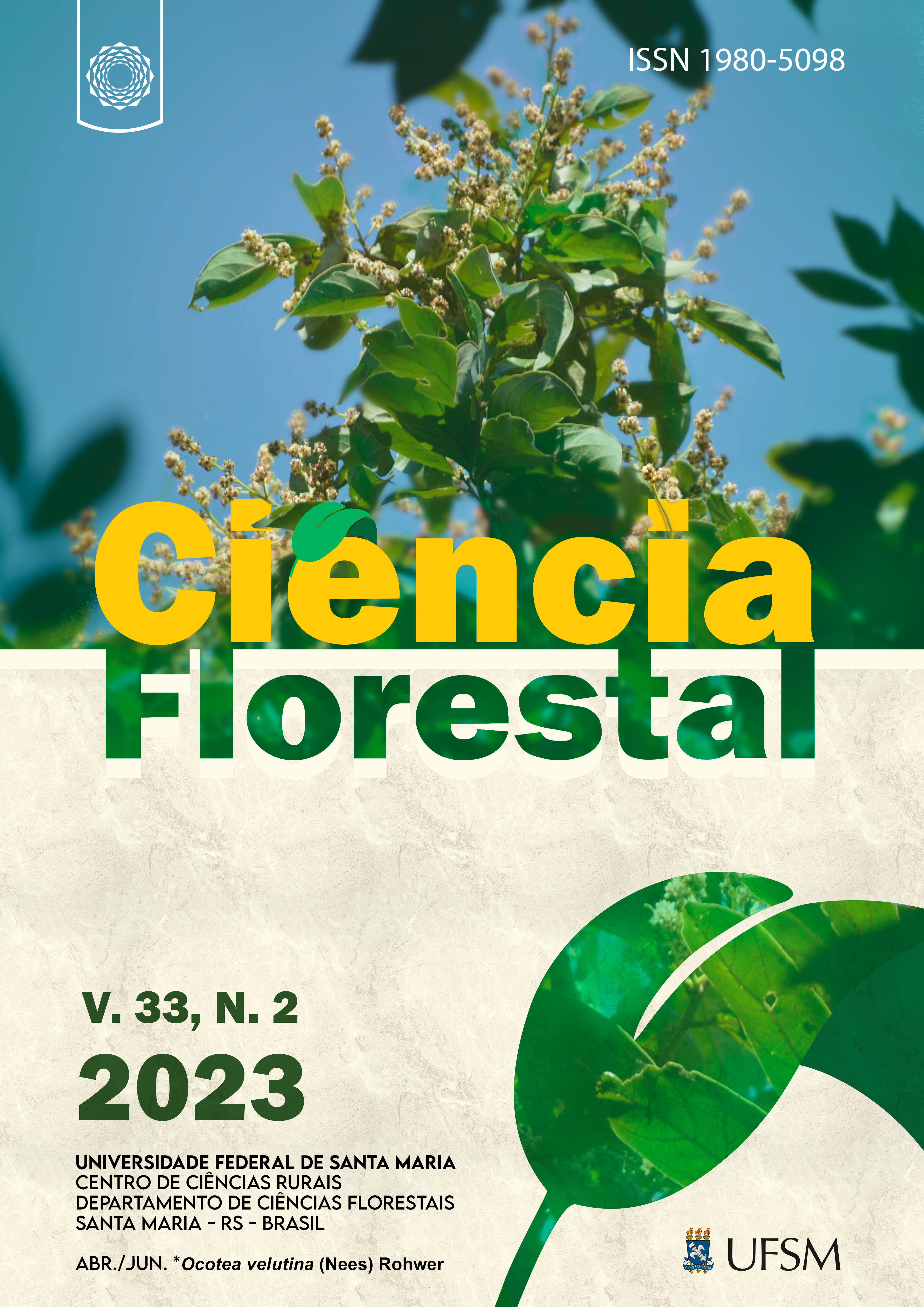Quality classification of black wattle trees biomass for energetic purposes
DOI:
https://doi.org/10.5902/1980509871436Keywords:
Bioenergy, Energy variables, Biomass componentsAbstract
One of the main difficulties in choosing forest biomass for energetic purposes is the evaluation of its quality. Thus, the objective of this research was to propose a classification of the biomass of black wattle stands based on the variables gross calorific value, energy density, ash content and biomass stock. For this purpose, commercial stands of the species were sampled in three growing regions (Cristal, Encruzilhada do Sul and Piratini) in Rio Grande do Sul, with 1 to 10 years old classified into age groups I, II, III and IV. In these stands, 670 trees were felled, their biometric and energetic variables were measured. From these locations, meteorological and edaphic variables were also collected. Cluster analysis was used to separate the predictor variables into three quality classes called low, medium and high. Discriminant analysis revealed two functions capable of classifying new observations into quality classes. The discriminant functions were able to correctly classify more than 51% of the trees based on gross calorific value, 65% based on energy density, 89% on ash content and 85% on energy stock. The biometric, energetic and meteorological variables contributed to the discrimination of the quality classes.
Downloads
References
AMERICAN SOCIETY FOR TESTING AND MATERIALS. ASTM D2395-14: standard test methods for specific gravity of wood and wood-based materials. Conshohocken: ASTM International, 2014. 13 p.
AMERICAN SOCIETY FOR TESTING MATERIALS. ASTM D1762-84: standard test method for chemical analysis of wood charcoal. West Conshohocken: ASTM International, 2013. 2p.
AMERICAN SOCIETY FOR TESTING MATERIALS. ASTM D5865-13: standard test method for gross calorific value of coal and coke. West Conshohocken: ASTM International, 2013. 19 p.
BEHLING, A. A produção de biomassa e o acúmulo de carbono em povoamentos de acácia negra em função de variáveis bioclimáticas. 2014.158p. Dissertação (Mestrado em Engenharia Florestal) Universidade Federal do Paraná, Curitiba, 2014.
CHAVES, A. M. B. VALE, A. T.; MELIDO, R. C. N.; ZOCH, V. P. Características energéticas da madeira e carvão vegetal de clones de Eucalyptus spp. Enciclopédia Biosfera, Goiânia, v.9, n.17, p.533-542, 2013.
COSTA JUNIOR, S.; SILVA, D. A.; BEHLING, A.; KOEHLER, H. S.; SIMON, A. A.; COSTA, A. Propriedades energéticas da biomassa de Acacia mearnsii De Wild. em diferentes idades e locais de cultivo. Scientia Forestalis, v. 49, n. 131, e3406. 2021. DOI: https://doi.org/10.18671/scifor.v49n131.04. DOI: https://doi.org/10.18671/scifor.v49n131.04
COSTA JUNIOR, S.; SILVA, D. A.; SANQUETTA, C. R.; BEHLING, A.; SIMON, A. A.; TRAUTENMULLER, J. W.; FERRAZ, F. A. Quantificação dos estoques de biomassa de Acacia mearnsii de Wild. em diferentes idades e locais de cultivo. Scientia Forestalis, Piracicaba, v.46, n.120, p.614-625, 2018. DOI: http://dx.doi.org/10.18671/scifor.v46n120.10. DOI: https://doi.org/10.18671/scifor.v46n120.10
ELOY, E. Produção e qualidade da biomassa de florestas energéticas no norte do Rio Grande do Sul, Brasil. 2015. 157p. Tese (Doutorado em Engenharia Florestal) Universidade Federal do Paraná, Curitiba, 2015.
ELOY, E.; CARON, B. O.; SILVA, D. A.; SCHMIDT, D.; TREVISAN, R.; BEHLING, A.; ELLI, E. F. Influência do espaçamento nas características energéticas de espécies arbóreas em plantios de curta rotação. Revista Árvore, Viçosa, v.38, n.3, p.551-559, 2014. DOI: https://doi.org/10.1590/S0100-67622014000300018
MIRANDA, R. L.; MARTINS, E. M.; LOPES, K. A Potencialidade Energética da Biomassa no Brasil. Revista Desenvolvimento Socioeconômico em Debate. v.5, n.1, p.94-106, 2019. DOI: http://dx.doi.org/10.18616/rdsd.v5i1.4829. DOI: https://doi.org/10.18616/rdsd.v5i1.4829
MOCHIUTTI, S. Produtividade e sustentabilidade de plantações de acácia-negra (Acacia mearnsii De Wild.) no Rio Grande do Sul. 2007. 270 p. Tese (Doutorado em Ciências Florestais) - Universidade Federal do Paraná. Curitiba, 2007. DOI: https://doi.org/10.5380/rf.v37i2.8654
MOMOLLI, D.R.; SCHUMACHER, M.V. Sustentabilidade de povoamentos de Acacia mearnsii De Wild. em diferentes idades: uma revisão da ciclagem de nutrientes. Revista Brasileira de Gestão Ambiental e Sustentabilidade. v.6, n.12, p.263-272, 2019. DOI: https://doi.org/10.21438/rbgas.061220. DOI: https://doi.org/10.21438/rbgas.061220
NUNES, L. J. R. A utilização de biomassa como alternativa energética para a sustentabilidade e competitividade da indústria portuguesa. 2015. 240 p. Tese (Doutorado Engenharia e Gestão industrial) - Universidade da Beira Interior, Covilhâ, 2015.
PICARD, N.; SAINT-ANDRÉ, L.; HENRY, M. Manual for building tree volume and biomass allometric equations: from field measurement to prediction. Rome e Montpellier: Food and Agricultural Organization of the Unites Nations and Centre de Coopération Internationale en Recherche Agronomique pour le Développement, 2012. 215p.
PROTÁSIO, T. P.; BUFALINO, L.; TONOLI, G. H. D.; COUTO, A. M.; TRUGILHO, P. F.; GUIMARÃES JUNIOR, M. Relação entre o poder calorífico superior e os componentes elementares e minerais da biomassa vegetal. Pesquisa Florestal Brasileira, v.31, n.66, p.113-122, 2011. DOI: http://dx.doi.org/10.4336/2011.pfb.31.66.113. DOI: https://doi.org/10.4336/2011.pfb.31.66.113
SILVA, D. A.; BEHLING, A.; SANQUETTA, C. R.; RUZA, M. S.; CORTE, A. P. D.; PSCHIEDT, H.; COSTA JUNIOR, S. Potencial dendroenergético dos diferentes compartimentos de Acacia mearnsii cultivada no estado do Rio Grande do Sul. Biofix scientific journal, Curitiba, v.2, n.2, p.71-75, 2017. DOI: http://dx.doi.org/10.5380/biofix.v2i2.55777. DOI: https://doi.org/10.5380/biofix.v2i2.55777
TANAC, Matéria prima. Manejo responsável, focado no bem do planeta. Disponível em: https://www.tanac.com.br/materia-prima/. Acesso em 04 ago. 2021.
Downloads
Published
How to Cite
Issue
Section
License
Copyright (c) 2023 Ciência Florestal

This work is licensed under a Creative Commons Attribution-NonCommercial 4.0 International License.
A revista CIÊNCIA FLORESTAL reserva-se o direito de realizar, nos originais, alterações de ordens normativas, ortográficas e gramaticais, com vistas a manter o padrão escolar da língua, mas respeitando o estilo dos autores. As provas finais podem ou não ser enviadas aos autores.






